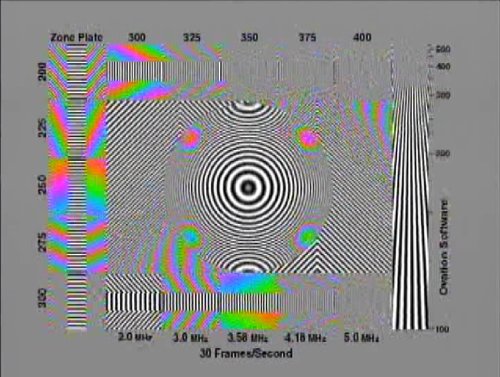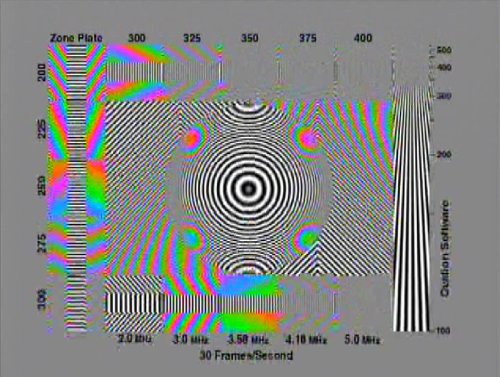The New Theater 650 TV Tuner Solution from ATI
by Josh Venning on June 14, 2006 4:00 AM EST- Posted in
- Smartphones
- Mobile
Image and Video Quality
Probably the most subjective yet important element of a TV tuner card is its ability to play and record high quality video. There are many factors involved in determining how good the video quality is and certain things like sharpness can be good or bad depending on user preference. That's why it's nice that ATI has added more user control over this and other aspects of image quality through the new software with the Theater 650.
ATI provided us with a DVD that contains some test videos to compare image quality between these three cards. To allay any suspicions of foul play, these test videos were created by SMPTE (the Society of Motion Picture and Television Engineers) for the express purpose of testing analog television quality. These videos include still and moving images to test how well a tuner applies things like sharpness and noise reduction. We recorded all of the tests with each of the tuners to provide a consistent test video for comparison between cards, and you can download the complete videos using your favorite BitTorrent client. (Total size of the three videos is 345 MB.) Note that we used ATI's AVIVO utility to convert all of the files to MPEG-4 format from the default MCE .ms MPEG-2 format. This was done to reduce file size, and we did verify that there was no discernible change in image quality (the original files totaled over 1 GB in size). In order to avoid any errors in our own analysis, we used the original files while drawing our conclusions.
It is also important to point out that we didn't just run a DVD player straight into a composite video input. We ran our DVD player through a modulator set up to output on channel 3. This way were were able to provide each card with a source data in the same format as if the images were broadcast and recieved over a cable connection. Feeding in analog video directly would bypass the tuner and demodulator on the card and wouldn't present a full test of the hardware, but our solution gives us the ability to repeat tests easily using a reliable source. The images below are taken from the original video files.
As we mentioned in the introduction, ATI has improved their 3D comb filter with the Theater 650 over the 550 by making it motion adaptive. This means that moving objects will be much cleaner and sharper compared to those without this feature. As you can see in the above images, the fruit in the Theater 650 capture looks similar to the 550, but the color is cleaner, especially near the edges of the tomato. You can also see that the DualTV has some problems with displaying the edges of the tomato and stand properly while in motion. This is one case where we see a clear improvement by ATI over NVIDIA in image quality.
In the above images, we can also see how there is slightly more detail in certain areas of the test pattern with the Theater 650 compared to the 550, and both are ahead of the DualTV. The loss of detail is noticeable near the upper and lower right hand corners of the image where some of the fine lines tend to blur together. There are also fewer color artifacts with the Theater 650 due to its higher quality 3D comb filter.
As a final example, we can see the difference in the color between the Theater 650 and 550 in these images, and the 650 gives the woman's skin tones a better treatment. There isn't a very big difference here between the Theater 650 and DualTV but you can see how the colors are generally brighter on the Theater 650 due to the new automatic color control.
These are only some of the tests on the DVD (there are eight tests in all) which demonstrate the Theater 650's better overall image quality than the 550. From these results we can definitely see how ATI has improved over the 550 as well the DualTV with their new Theater card.
Probably the most subjective yet important element of a TV tuner card is its ability to play and record high quality video. There are many factors involved in determining how good the video quality is and certain things like sharpness can be good or bad depending on user preference. That's why it's nice that ATI has added more user control over this and other aspects of image quality through the new software with the Theater 650.
ATI provided us with a DVD that contains some test videos to compare image quality between these three cards. To allay any suspicions of foul play, these test videos were created by SMPTE (the Society of Motion Picture and Television Engineers) for the express purpose of testing analog television quality. These videos include still and moving images to test how well a tuner applies things like sharpness and noise reduction. We recorded all of the tests with each of the tuners to provide a consistent test video for comparison between cards, and you can download the complete videos using your favorite BitTorrent client. (Total size of the three videos is 345 MB.) Note that we used ATI's AVIVO utility to convert all of the files to MPEG-4 format from the default MCE .ms MPEG-2 format. This was done to reduce file size, and we did verify that there was no discernible change in image quality (the original files totaled over 1 GB in size). In order to avoid any errors in our own analysis, we used the original files while drawing our conclusions.
It is also important to point out that we didn't just run a DVD player straight into a composite video input. We ran our DVD player through a modulator set up to output on channel 3. This way were were able to provide each card with a source data in the same format as if the images were broadcast and recieved over a cable connection. Feeding in analog video directly would bypass the tuner and demodulator on the card and wouldn't present a full test of the hardware, but our solution gives us the ability to repeat tests easily using a reliable source. The images below are taken from the original video files.
As we mentioned in the introduction, ATI has improved their 3D comb filter with the Theater 650 over the 550 by making it motion adaptive. This means that moving objects will be much cleaner and sharper compared to those without this feature. As you can see in the above images, the fruit in the Theater 650 capture looks similar to the 550, but the color is cleaner, especially near the edges of the tomato. You can also see that the DualTV has some problems with displaying the edges of the tomato and stand properly while in motion. This is one case where we see a clear improvement by ATI over NVIDIA in image quality.
In the above images, we can also see how there is slightly more detail in certain areas of the test pattern with the Theater 650 compared to the 550, and both are ahead of the DualTV. The loss of detail is noticeable near the upper and lower right hand corners of the image where some of the fine lines tend to blur together. There are also fewer color artifacts with the Theater 650 due to its higher quality 3D comb filter.
As a final example, we can see the difference in the color between the Theater 650 and 550 in these images, and the 650 gives the woman's skin tones a better treatment. There isn't a very big difference here between the Theater 650 and DualTV but you can see how the colors are generally brighter on the Theater 650 due to the new automatic color control.
These are only some of the tests on the DVD (there are eight tests in all) which demonstrate the Theater 650's better overall image quality than the 550. From these results we can definitely see how ATI has improved over the 550 as well the DualTV with their new Theater card.



















78 Comments
View All Comments
Mumrik - Thursday, June 15, 2006 - link
Still, why didn't you touch on the Hardware DRM?None of us know what this element means for the card and it MIGHT just be the deal breaker that makes this card WORSE than the 550.
You need to look into stuff like that, or somebody's going to make a purchase based on this "review" and quite possibly be very disappointed.
LoneWolf15 - Thursday, June 15, 2006 - link
Below are the updates I found for the Hauppauge WinTV PVR-150, the card that has mostly replaced the PVR-250 with better quality and a single chip solution
http://www.hauppauge.com/pages/support/support_pvr...">http://www.hauppauge.com/pages/support/support_pvr...
Name: pvr150_500_basedriver_2043_24103.zip
Size: 2.2MB
Updated: April 13, 2006
WinTV2000 application update for the WinTV-PVR-150
Name: wintv2k411_23347.exe
Size: 2.5 Mb
Updated: Dec. 15, 2005
WinTV video decoder update
Name: hcwsmd05_23290.exe
Version: 5.0_23290
Size: 1996K
Updated: Oct. 17, 2005
I'd call that updated in the past year. When video cards are updated, Anandtech and others test to see if increased performance and/or image quality results. Are you saying the same should not be done with TV Tuner cards?
P.S. I could be wrong, but I don't recall you testing the WinTV PVR-150, which is considered by most HTPC enthusiasts to be a much better replacement of the PVR-250. If I'm wrong, apologies. If I'm right, then Hauppauge's cards have changed indeed since you tested the PVR-250.
BigLan - Thursday, June 15, 2006 - link
"The Hauppauge cards haven't really changed at all in over a year. Do we need to include socket 754 Athlon 64 and Pentium 4 478 in current CPU articles? Do we need to talk about the Radeon X800 and GeForce 6800 cards in new GPU reviews?"Two problems with this, Jarred. First is that the Hauppauge 250 got replaced with the 150, which offered better image quality and a lower price. Anand has never compared the 150 to the 550, or any other card. Sure you can say it's similar to the MCE500, but you didn't mention that in this article, only the 250.
Next up is that you actually did compare the X800 and 6800 cards to modern GPUs in the Oblivion article.
Crucial - Thursday, June 15, 2006 - link
If the S754 and S478 cpus were the last ones to be made and still the more popular cpu your darn right you do. The comparison to video cards and cpu's doesn't hold up because there aren't new tuner cards coming out every 6 months. Many people here don't agree with the statements that the 650 screenshots look better. Just because somethings new doesn't mean it's automaticaly better.
As for that comment, are you writing these reviews for yourself or for the readers of the site? With an attidude like this it's no wonder the review doesn't cover half of what it should.
Basically it sounds to me like you only have a Theatre550 card and dont want to take the time or spend the money to review a hauppage card. That or ATI is pulling the strings and won't let you. If thats the case just say so and alot of the flack will go away. You can try and justify your attitude towards these reviews but it is not what a majority of the readers want to see.
hondaman - Wednesday, June 14, 2006 - link
Thats some seriously flawed logic. In every review, one _always_ compares, HEAD TO HEAD, the king(s) of the hill vs. the newcommers. This goes for cpus, video, hd's, and yes, even capture cards.
The bottom line duty of a capture card is to capture video. It doesnt matter an ounce that you previously reviewed a card. Image quality is something we must see for ourselves, and allow us to decide what looks best. That means running the SAME tests on the SAME capture cards.
jeremyk442 - Wednesday, June 14, 2006 - link
Am I the only one who seems to think that the 650 looked worse than the 550 on the tomato shot? The differences in the stills were extremely subtle and give no indication of how much difference you would notice while using it. And this whole review felt like an advertisement for ati's new chip rather than a valid comparison (especially the image quality).JNo - Saturday, June 17, 2006 - link
I agree. The 650 was praised (vs the 550) for warmer colours but in actual fact, the 550 shot was the only one where the woman's skin tone seemed more natural and you could make out extra *details* on her that were smoothed over in the other 2 cards e.g. just above and below her lips if I remember correctly. "Brighter" colours aren't always better if they just create colours that aren't in the signal. Hey, we could all just turn up the colour bar on our TVs for a better picture if that were the case...BigLan - Wednesday, June 14, 2006 - link
Looking closer at the tomato shot, I think there's something messed up in the GualTV test. It looks like there's some ghosting going on, which is either a problem with the tuner chip or a problem with the setup. I don't believe that the dual tuner could have that big an issue tuning channels without the community having noticed by now, which suggests the test setup is wrong.mostlyprudent - Wednesday, June 14, 2006 - link
This is a relatively new area of interest for me. Can some one point me to some information on which, if any, of these cards supports a signal from setalite sources? I have a dual tuner receiver and want to use my PC as the other output (my DVR is filling up and I would like to capture some of the prgramming to archive on my hard drive). Wow, I feel like a newbie!SHSPVR - Wednesday, June 14, 2006 - link
No it do not supports a signal direct from setalite LNB you must used a sat receiver and I hate tell you but dual tuner sat receiver suck becuase of the fact that there are NO Blaster that support UHF Transmit signal so there for your SOL with 2nd TV output but you can setup the 1st TV output becuases it base on Standard IR Transmit signal.